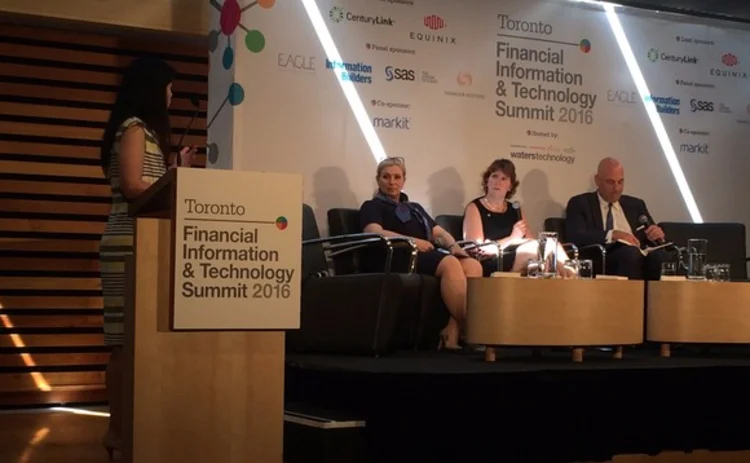Communication Key to Regulatory Influence, Gaining Better Support from Rule Makers
Opening the lines of communication is the answer to questions around effecting regulatory evolution and getting regulatory aid.

The answer to both of those questions is communication, according to panelists at the Toronto Financial Information and Technology Summit 2016.
Allie Harris, who is involved in the data governance and analytics space at Bank of Montreal (BMO), said there needs to be more inter-regulatory communication.
"Have the conversation," Harris said. "They're all looking for the same thing from the same people. How do they go about that intelligently?"
Tim Lind, global head of financial regulation solutions at Thomson Reuters, agreed with Harris and criticized the current processes in place.
"Comment letters don't work," Lind said. "If that's the main mechanism by which regulators obtain feedback on the efficacy of any proposed legislation, it doesn't work."
"Help drive the bus instead of taking it on the chin after it's been formulated and you have no choice but to react to it," Lida Preyma, BMO
Lind said regulators need to fully understand the implications of the laws they are considering implementing.
How does a new regulation take liquidity out of the marketplace? How does it impair an investment manager's ability to buy and sell corporate debt? These are just some examples Lind provided of things that need to be considered by regulators.
"That's the type of communication and understanding of how capital markets work, how market structure works, that regulators are going to need to be able to understand effective policy," Lind said.
Power in Numbers
Harris, Lind and Sydney Hassal, associate director of global capital markets banking at Scotiabank, all agreed that participation in member organizations is the best way a firm can impact regulatory evolution.
"Being involved in member organizations is the way to respond to regulators," BMO's Harris said. "Those are the places where business and regulatory meet."
Lind agreed, adding that his firm has representation in Brussels and Washington. He said Thomson Reuters always looks to help regulators better understand the complex nuances of the industry, such as how a collateralized mortgage obligation works, and what underlying cash flow is.
Hassal said legal memoranda are also heavily relied upon.
"Their interpretation and how they manage those and how they work those is really, really critical to influencing how regulation is driven and interpreted," Hassal said.
Lida Preyma, director of global anti-money laundering (AML) compliance and AMLRO designate for BMO Capital Markets, said it comes down to getting involved in the process.
"So what I'm hearing again is communication. Getting there, get your seat at the table," said Preyma, who moderated the panel. "Help drive the bus instead of taking it on the chin after it's been formulated and you have no choice but to react to it."
Only users who have a paid subscription or are part of a corporate subscription are able to print or copy content.
To access these options, along with all other subscription benefits, please contact info@waterstechnology.com or view our subscription options here: http://subscriptions.waterstechnology.com/subscribe
You are currently unable to print this content. Please contact info@waterstechnology.com to find out more.
You are currently unable to copy this content. Please contact info@waterstechnology.com to find out more.
Copyright Infopro Digital Limited. All rights reserved.
As outlined in our terms and conditions, https://www.infopro-digital.com/terms-and-conditions/subscriptions/ (point 2.4), printing is limited to a single copy.
If you would like to purchase additional rights please email info@waterstechnology.com
Copyright Infopro Digital Limited. All rights reserved.
You may share this content using our article tools. As outlined in our terms and conditions, https://www.infopro-digital.com/terms-and-conditions/subscriptions/ (clause 2.4), an Authorised User may only make one copy of the materials for their own personal use. You must also comply with the restrictions in clause 2.5.
If you would like to purchase additional rights please email info@waterstechnology.com
More on Regulation
Off-channel messaging (and regulators) still a massive headache for banks
Waters Wrap: Anthony wonders why US regulators are waging a war using fines, while European regulators have chosen a less draconian path.
Banks fret over vendor contracts as Dora deadline looms
Thousands of vendor contracts will need repapering to comply with EU’s new digital resilience rules
Chevron’s absence leaves questions for elusive AI regulation in US
The US Supreme Court’s decision to overturn the Chevron deference presents unique considerations for potential AI rules.
Aussie asset managers struggle to meet ‘bank-like’ collateral, margin obligations
New margin and collateral requirements imposed by UMR and its regulator, Apra, are forcing buy-side firms to find tools to help.
The costly sanctions risks hiding in your supply chain
In an age of geopolitical instability and rising fines, financial firms need to dig deep into the securities they invest in and the issuing company’s network of suppliers and associates.
Industry associations say ECB cloud guidelines clash with EU’s Dora
Responses from industry participants on the European Central Bank’s guidelines are expected in the coming weeks.
Regulators recommend Figi over Cusip, Isin for reporting in FDTA proposal
Another contentious battle in the world of identifiers pits the Figi against Cusip and the Isin, with regulators including the Fed, the SEC, and the CFTC so far backing the Figi.
US Supreme Court clips SEC’s wings with recent rulings
The Supreme Court made a host of decisions at the start of July that spell trouble for regulators—including the SEC.








